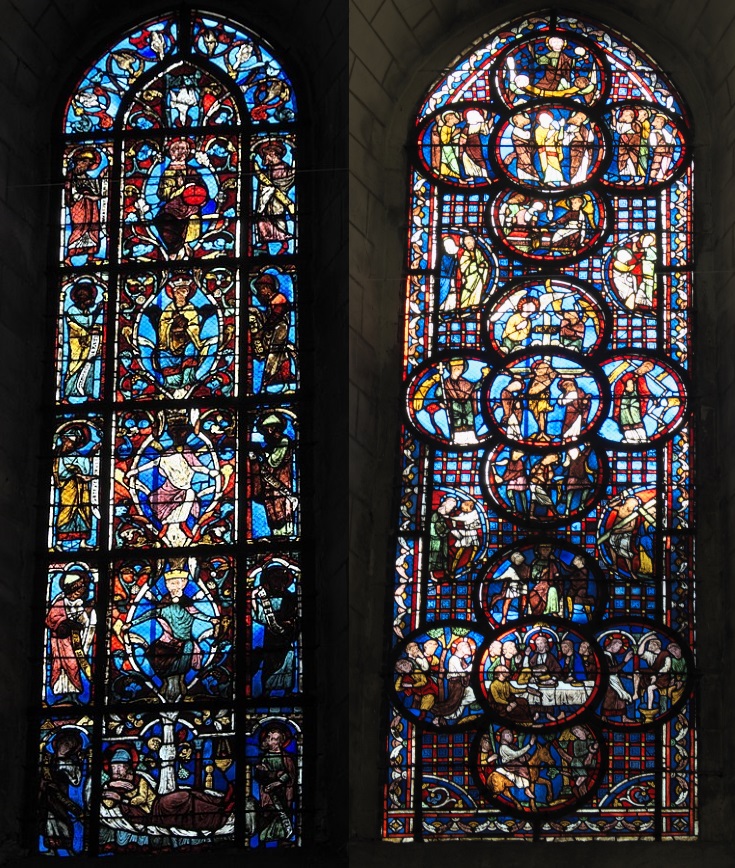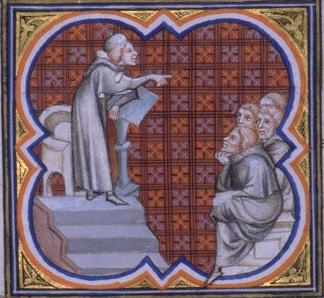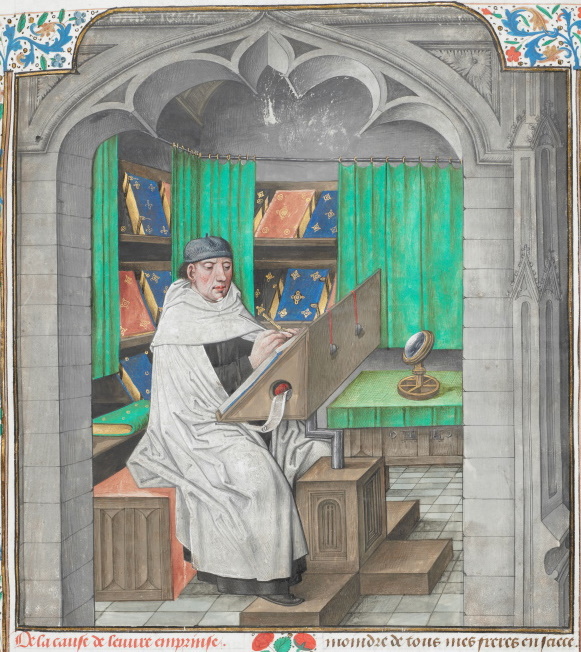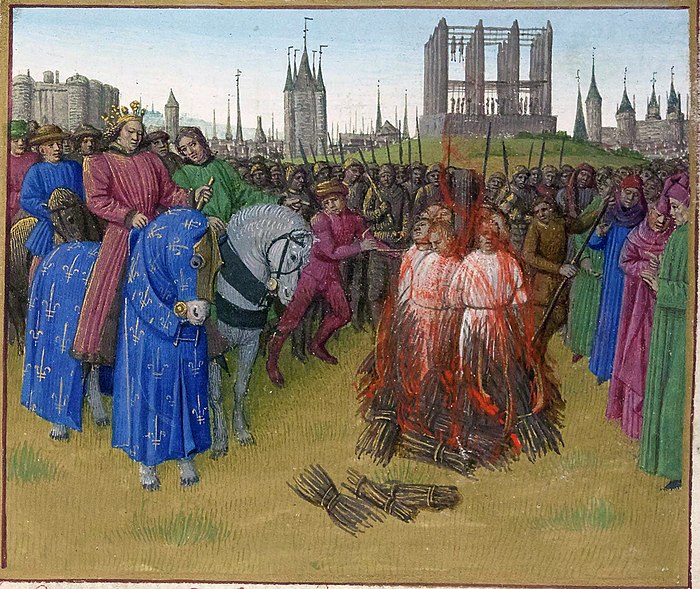Magister Amalricius

| “Stained glass windows of the chancel in the parish church of Saint-Germain-lès-Corbeil (on the right bank of the Seine) constructed during the transition from Romanesque to Gothic. “The Vieux-Corbeil Jesse tree [left] grows up to Christ, as expected, but differs from the larger Chartres version by culminating in the dove of the Holy Spirit at the top. The prominence given to the Holy Spirit, would have been pleasing to an Amalrician. “The window [right] implicates the three principal stages of the mystical development of the individual, as well as the last deeds of Christ.” i |
The Amalrician offshoot
As a continuation of the previous essay on the Chartrian School, the contention by orthodoxy towards their philosophy was the perceived belief in divine immaency and permeation by the Holy Spirit within creation. The catch is how evil, sin and resulting disease can exist within, at one, or along with, an imminent divine presence: The Chartrians were never forthcoming with any workaround.

Enter, Magister (Master) Amalricius, known through Guillaume le Breton’s (William the Breton, c.1165–c.1225) chronicle as Amaury de Beynes: born in the latter half of the C12th in the village of Beynes, situated in the diocese of Chartres and in the territory of Gui de Montfort.1 His volte-face legacy perhaps inspired Anonymous of Laon to say of him, that in whatever subject he was studying, he was always found to take a position that was opposed to the rest.1
To provide a backdrop to Amaury in the light of the humanist philosophies taught in the Schools of Chartres and of Paris, we can again draw upon Ellard (2008) and Chenu (1957). The former shows us how, although the Integument hypothesis was not widely considered during the second half of the C12th, the perception by orthodoxy of pantheistic causality and divine immanency held within the belief may well have been their misunderstanding.5
In contradistinction, Chenu highlights that the relatively well approved symbolist development to the humanism in vogue around the same time was rather rooted in Augustine’s technical verbal distinction between the vestigial of God in the physical universe and the imago of God in man. From here was conceived a whole vestige of medieval “speculum literature” or “mirror of God” symbolism.2 This speculum projected its reflection well into the 16th Century, perhaps culminating in the pseudo-graphical Speculum alchimiae “Mirror of Alchemy” (trans.1597), attributed to Roger Bacon (c.1220 – c.1292).
As a veritable “hall of mirrors” refracted through time, we may also note Honorius Augustodunensis‘ (c.1080–1154) Speculum vel imago mundi as a precursor for Vincent of Beauvais’ (c.1184–c.1264) Speculum natural “mirror of nature”7 (1235–1264).

Otherwise, we also see the Victorine lyric discourse upon nature, “book” and “finger of God” that one reads in Hugh of St Victor’s (c.1096–1141) De tribus diebus (On the Three “Days” c.1141)2; William of St-Thierry’s (c.1075–1148) Speculum fidei “Mirror of Faith” (1142–1144); Chrétien de Troyes (fl. 1160–1191) use of Speculum principis and lectoris as a literary device, aimed at moral precepts and reorientation of tastes in his readers, respectively8; and, Alan of Lille’s (c.1128–c.1203) Every creature is, for us, like a book and a picture and a mirror as well, from his poem Rhythmus Alter (c.1200), where the author represents there, in a very elegant manner, the instability of human life under the image of a flower which the same day sees born and die.3
Forthwith, the same Speculum – mirror image of God in creation and in man – through which Hugh of St. Victor attempted to dissipate its reflections in translatio (as per pseudo-Dionysius’ via negativa), while at the same time holding it up against William of Conches’ (c.1090–after 1154) projection of divine thought2, really only served to deflect the significantly parallel but at the same time misunderstood mainstem of Chartrian divine Integument.
Of note, we might witness another offshoot whereby the Integument develops into allegory in the Chartrian student Bernardus Silvestris’ Cosmographia –an allegorical discourse on how the goddess Natura appeales to Noys (divine mind) and Silva (Hyle; chaos) to bring about creation. Although it was built upon Eriugena’s (John Scotus, 735–804) banned Neoplatonic work, Periphyseon (About the Physical Universe),13 the humanist clerics considered allegory to be watered down symbolism that became a trope – i.e. loosing something of the true divine picture. Ironically, allegory as a genre was, by reflection, later to reach its true flowering in the works of Dante Alighieri (c.1265–1321), where his Divina Commedia (The Divine Comedy, 1308-21) represents the soul’s journey towards God.
In the Periphyseon: the whole of reality or nature, is involved in a dynamic process of outgoing (exitus) from and return (reditus) to the One, whereby God is the One or the Good or the highest principle, which transcends all, and which therefore may be said to be “the non-being that transcends being”. In an original departure from traditional Neoplatonism, the dialogue confers this first and highest cosmic principle to be called “nature” (natura) that is said to include both God and creation.14
Ellard, moreover, considers that the Chartrian School as a whole had ignored the Periphyseon or at best, given only a token acknowledgment to Eriugena’s Latin translation from the Greek pseudo-Dionysius (the Areopagaite, fl. c.500). Previous clerical scholars had found what extracts of his works they possessed to be undecipherable,1 but for the Chartrians, although not incongruous to the structure of their philosophy – based upon the Aristotlean four causes – it was still mystically Illuminist in its theme.
Notwithstanding, the Integument hypothesis was remarkable for its time in that it correctly resolved Aristotelian logic with Platonic dialogue (as per Boethius) in a way that materially clothed Aristotle’s essential form/s to generate multiplicity within creation. In this way, was the formal Divine Unity transcendent of any material Integument (material crust or clothing) by the four elements, but at the same time giving expression to it.5
In the same way, Eriugena (also after Boethius) had likewise resolved the Aristotelian essential forms along with the universal Platonic ideas to provide something working towards a theistically transcendent – creates but is not created – divinity by Integument:
In the realm of space and time the ideas take on the burden of matter and become subject to multiplicity, change, imperfection, and decay. The material world, therefore, of our experience is composed of ideas clothed in matter.6
The Method of Return to God
Despite Eriugena’s inferred theism, we can still note a pantheistic method of return:
He [Eriugena] treats of the essentially dialectical relation between Creator and created, where God expresses Himself in creation and creation culminates in return to the divine.6
To expand the picture somewhat: at the conclusion of the Chartrian essay, we had already distinguished between Pantheism and Panentheism; the latter as an inherently divine factor in divine Integument while at the same time, being transcendent to it. Considering that there are evident similarities of divine return expressed by the Amalrici in the light of Eriugena’s works, Braid (2011) is doubtful of the availability to them, other than extracts from the Periphyseon.
As already mentioned however, Ellard provides reference to his Latin translation of pseudo-Dionysius1 known to Thierry of Chartres, and again Wetherbee (1990) does speculate upon a more direct transference of his Neoplatonic ideas into the playing field:
There is no doubt that a certain osmosis took place between the Chartrian view of universal reality, centered primarily on the implications of structure and analogy, and the Neoplatonism which emerged, largely under the influence of the pseudo-Dionysius and Johannes Scotus Eriugena, in such authors as Honorius Augustodunensis and Hugh of St. Víctor, and which conceived the universe as charged in all its parts with mystical significances which coalesce in a “theophany,” a manifestation of God.13
In spite of whether or not the Amalrici had recourse to banned works, and akin to their Chartrian predecessors before them, they were still forced into theological and philosophical wrangling. Although the kind of heretical finger pointing towards pantheistic rhetoric was again temporarily rebuffed, unfortunately, by the turn of the 13th Century, the orthodoxy was not so open minded or lax.1
As an example, Master Amalricius, being a top rate Logician, drew upon the relevant New Testament passages: The passages from Romans and Corinthians that specified such sentiments as, we are one body in Christ and our bodies are members of Christ, joined to him in spirit.1 In spite of this, the Amalrician approach to self-deification became their attitude; their methodology, their undoing.
Unlike the glimpses of ‘Inner Light’ gleaned through the contemplations of Cistercians: mystics such as Hildegard of Bingen, Theresa of Avila or Julian of Norwich; or later illuminists such as the Quakers,4 the Amalrician stance towards the Holy Spirit was deemed inherently dangerous.
The Amalrici were ipso facto original “New Age” believers. At least in the sense that Stephanus, priest of la Celle and later, Joachim of Fiore, admitted to preaching on the age of the Father, that of the Son and that of the Holy Spirit.1
According to Braid, what the newly dawned ‘Age of the Holy Spirit’ proclaimed to the Amalrici was that, through the illumination of Christ within themselves, the Holy Spirit not only revealed all things to them, but dwelt within them as an Inner light of absolute authority. In other words they were themselves becoming ‘Christs.’1
Indeed, to highlight another parallel, Eriugena, in his Voice of the Mystic Eagle had said of St. John, He could not otherwise have ascended into God, if he had not first been made god.1
As already cited, the mainstream symbolist (as per the Summa of Alan of Lille) or the Victorine approach was that, [p]articipation in the transcendent was not felt to be a matter of identity with it (“identity was a term proper to conceptual logic); rather, such participation was sensed through a dialectic of the similar-dissimilar within a “figure” within the coexistence of the sensible and the spiritual.2 In any case, Hugh of St. Victor saw in the material world, something of a prison.1
Antithetically, to be seen somewhat in favour of Master Amalricius, Braid does at least make reference to the Cistercian Abbot Guerric’s d’Igny’s bequest: He informed his monks that they could be mothers of Christ, because they could bring Christ to birth in themselves!1
Moreover, St. Bernard, founder of the Abbey at Clairvaux, although today seen as a mystic, had been quick to reiterate the difference between Holy Spirit as comforter rather than absolute authority.1 Perhaps the Pope was feign to relinquish any of his own Papal supremacy to a discommodious Holy Spirit that conferred spiritual gifts and divine authority upon any post-gentile convert, not least an Abbot.
Braid continues that, at the time of their founding, the prototype Cistercians, at the end of the 11th Century, were reacting to and retreating from a more worldly and politically involved Church of Rome. Perhaps at the time, the Church was sensitive to their hypercriticism and relented to their needs and wishes. In the second instance, Bernard was clever enough to side-step his Inner light when he limited it to the possibility of occasional glimpses of perhaps ‘half an hour,’ gleaned he said, despite the obfuscation of ‘dark inner clouds.’1
Another contention recorded by their contemporary medieval chroniclers, again pointed out by Braid, was that the Amalrician priests had women followers. The women in question did not read Latin or study theology. The priests moreover, were able to provide vernacular translations. The textual regurgitation was then consumed emotionally by the women into personal religious experience.1
If we are to witness an attempt to substitute Eucharist, the actual Eucharist was disregarded by the Amalricians. Their reasoning was simply that, if the Holy Spirit is divinely imminent within everything, then how can the consecrated host be more sacred than anything or anywhere else?
Whether or not any sexual relations the priests had with their female followers was consensual, the same chroniclers imagined the worst. As recurred with the Templar Order, they dug deeper to accuse them of adulteries and homosexual practices. Braid even quotes, Caesarius [a chronicler] was sure that they held that anyone who lived ‘in the spirit’ could not sin.1
As far as the heresy goes, Braid shows in context that Illuminism was one of the four named heresies, the other three being dualist, reformist and rationalist.1 As vindicated by the orthodoxy then, the dangers of holding an illuminist or pantheistic doctrine that included ‘free love’, had subsequent resurfacings in the following centuries: In other words, it was a case of “I told you so.”
An instance of such a resurfacing is included in Adam Thorpe’s novel, Hodd.’10 In contradistinction to the Cathari, Hodd (Robin Hood) is a follower of the ‘heresy of the free spirit.’ This particular heresy periodically surfaced in Europe between the 12th to 15th Centuries. It included, but was certainly not limited to, The Brethren of the Free Spirit:
“Thou shall not slay,” I cited, marvelling at the way my words came out of my mouth as if writ there by a pen. ‘Nothing is a sin’, he replied, “when you are pure essence and the source of all Creation.” Then said I: “This that you say being the sin of presumption,” accepting with equanimity the manner in which the walls were covered now in shifting shapes as brilliantly hued as the freshly painted walls and columns of a church.
“There is no sin,” he repeated, his words blurring deliciously [suaviter] inside my head. “The one who is perfect, who has attained perfection, cannot sin even if he wished to, for everything he does is necessarily perfect.”10
The Demise of the Amalricians
Paraphrasing Thijssen (1996) he writes, it was the day after the annual fair that on 20th November 1210 the remaining ten heretic followers of the previously condemned [1206] Master Amalric of Bène were burned outside the walls of Paris, in a field named Champeaux.9

Artist : Jean Fouquet, Date : 1455-1460, Source : Bibliothèque nationale de France, Paris iv
As the 12th Century progressed into the 13th, the legacy of the self-styled Platonic schools (with Neoplatonic dressings), faded out and the Liberal Arts of antiquity lost most of their spiritual element. Through Aristotlean logic, the subsequent scholasticism, even if reinterpreted under natural philosophy, became a dry and pedantic ideologue.
This may not all be the fault of Aristotle, but rather by the Christian review of his now banned works and subsequent re-editing by St. Thomas Aquinas; ironically he was a Platonist in the Augustinian sense.11 It is through the influence of Aquinas, that we may see the roots of the eventual split between spirituality and rational science.
It is too much to debate the split in this short piece. Howbeit, the given references for this essay provide an adequate picture to those willing and able to wade through the philosophical mind field.11 Simply put, Aquinas put to bed, through a series of Platonic dialogues called Summa Theologica, the limitations of natural reason in approaching the divine and was content to leave the rest to faith.12
In conclusion, the Amalrici, in lieu of their own Neoplatonic interpretations, had grown too hyperbolic an offshoot to the Chartrian mainstem; so what if any legacy can we draw from them?
Although we have already pointed to the subversive back-road of the free spirit, Braid provides this addition:
When the Amalricians were sentenced in Paris, they were all degraded from their orders, – which shows that they were all clerics. One of their (perhaps self-appointed) spokesmen, however, was called Guillelmus de Arria aurifaber (William the goldsmith from Aire) or Wilhelmus Aurifex propheta eorum (William the gold-maker, their prophet). Wilhelmus cannot have been a goldsmith by trade, because he was a cleric, a student of theology and either a deacon or a priest. What, then, was the significance of his name, aurifex, the gold-maker? It is almost certain, as the historian Norman Cohn suggested, that the name was derived from the symbolism of alchemy. In alchemy, the Amalricians could have found teachers of mystical techniques.1
Bringing back to mind the stained glass window at Saint-Germain-lès-Corbeil, this could may well hint at an alchemical route to the “three mystical stages of individual development”1 quoted at the commencement of this essay.
In forthcoming essays, aspects of Western European Alchemy, from its late C12th roots to its C14th Century flowering and beyond, will of course be explored.

References
- Braid, Angus. J., Mysticism and Heresy: Studies in Radical Religion in the Central Middle Ages (c.850-1210), WritersPrintShop; 1st Edition (26 Sept. 2011)
- Chenu, M. D. (1957) Nature, Man, and Society in the Twelfth Century: Essays on New Theological Perspectives in the Latin West, University of Toronto Press; 37th Revised ed. Edition (8 Mar. 1997)
- Collective (Ed. Royal Academy of Belgium), National Biography of Belgium, Vol. I, H. Thiry-Van Buggenhoudt (1866)
- Cantor, Geoffrey, The Bible, the Creation, and the Inward Light: Tensions within Quaker Science, University of Leeds
- Ellard, Peter, The Sacred Cosmos: Theological, Philosophical, and Scientific Conversations in the Twelfth Century School of Chartres, University of Scranton Press (June 1, 2008)
- Moran, Dermot, John Scottus Eriugena, The Stanford Encyclopedia of Philosophy (Fall 2008 Edition), Edward N. Zalta (ed.)
- Franklin-Brown, Mary, Reading the World: Encyclopedic Writing in the Scholastic Age, University of Chicago Press (1 Sept. 2012)
- Reichert, Misher Bracha, Between Courtly Literature and Al-Andaluz: Oriental Symbolism and Influences in the Romances of Chretien de Troyes (Studies in Medieval History and Culture, Routledge; 1st edition (January 14, 2014)
- Thijssen, J. M. M. H., Master Amalric and the Amalricians: Inquisitorial Procedure and the Suppression of Heresy at the University of Paris, Speculum Vol. 71, No. 1 (Jan., 1996), pp. 43-65 (23 pages), The University of Chicago Press
- Thorpe, Adam, Hodd, Vintage (13 May 2010)
- Victor ?, Critically Examine Aristotle’s Theory Of Causation: A critique of Aristotle`s ideas on causation, https://www.tutorhunt.com/resource/19858/
- Wertz, Jr. William F., Why St. Thomas Aquinas Is Not an Aristotelian, Fidelio Volume 2, Number 1, Spring 1993, Schiller Institute.
- Wetherbee, Winthrop, The Cosmographia of Bernardus Silvestris (Records of Western Civilization Series), Columbia University Press (5 Jan. 1990)
- Zalta, Edward N. et al, Stanford Encyclopedia of Philosophy,
Metaphysics Research Lab, Center for the Study of Language and Information, Stanford University (March 2018) https://plato.stanford.edu/index.html
Image source:
- Saint-Germain-lès-Corbeil Église, WikiCommons, (https://commons.wikimedia.org/wiki/File:Saint-Germain-l%C3%A8s-Corbeil_%C3%89glise_Saint-Vincent-Saint-Germain_Vitrail_383.jpg)
- 14th century picture of Amalric of Bena. He appears to be teaching people, WikiCommons, (https://commons.wikimedia.org/wiki/File:Amalric_of_Bena_(Clean).jpg)
- This author portrait of Vincent of Beauvais in a manuscript of his Speculum Historiale, contains an actual convex mirror as a visual pun. French translation by Jean de Vignay, Bruges, c. 1478–1480, for Edward IV;British Library, WikiCommons, (https://commons.wikimedia.org/w/index.php?search=Vincent+of+Beauvais+Speculum+Historiale&title=Special:Search&go=Go&ns0=1&ns6=1&ns12=1&ns14=1&ns100=1&ns106=1#/media/File:BL_Royal_Vincent_of_Beauvais.jpg)
- Illustration from the illuminated manuscript Grandes Chroniques de France depicting the burning of Amalrician heretics before King Philip II of France. In the background is the Gibbet of Montfaucon and, anachronistically, the Grosse Tour of the Temple fortress.
Artist : Jean Fouquet, Date : 1455-1460, Source : Bibliothèque nationale de France, Paris,WikiCommons, https://commons.wikimedia.org/w/index.php?search=burning+of+Amalrician+&title=Special%3ASearch&go=Go&ns0=1&ns6=1&ns12=1&ns14=1&ns100=1&ns106=1#/media/File:Supplice_des_Amauriciens.jpg)